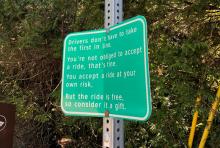Progress is being made on a study being carried out in North America of the risk to road users from wildlife. The study is being carried out by Leonard Sielecki at the University of Victoria and covers Canada and the US. This investigates the risk to road users posed by animals entering the roadway and considers the benefits of technologies to warn drivers of such risks. According to Sielecki, over 500 people have so far responded, considerably in excess of the number expected. Of these respondents, around
Progress is being made on a study being carried out in North America of the risk to road users from wildlife. The study is being carried out by Leonard Sielecki at the University of Victoria and covers Canada and the US. This investigates the risk to road users posed by animals entering the roadway and considers the benefits of technologies to warn drivers of such risks. According to Sielecki, over 500 people have so far responded, considerably in excess of the number expected. Of these respondents, around 95% have been from the US or Canada as expected, however the remaining 5% have come from a further nine countries. This last point reveals the potential benefit from such warning technology for markets outside of the US also.
The risk of a vehicle impacting with a large animal can be severe in many areas of the world, particularly in rural locations. This can result in major damage to vehicles and serious injuries and fatalities to vehicle occupants.
So far 92% of the respondents have said that they would like a system like the Wildlife Hazard Warning System used on roads and highways, according to Sielecki. He said that the survey participants were well representative of the general driving population in the US and Canada, ranging in age from 19 to over 75. The participants were evenly divided between males and females, while their driving habits ranged from "For pleasure" only to "For pleasure/to work/for work/to school". In addition, the participants lived in all types of locations, encompassing rural and small communities as well as large urban centres.
In addition to the development of the Wildlife Hazard Warning System concept, Sielecki’s research has examined how the US deer-vehicle collision phenomena developed over the last 100 years, in part, as a result of US state and federal government involvement in deer population management. The research also investigates how US state driver licensing authorities have been advising drivers of the deer hazard as the hazard has grown.
As part of the research, Sielecki collected and reviewed over 500 US state driver manuals published since the early part of the 20th century and he believes that as a result, he now has more US state driver manuals even than the US Library of Congress.
The survey has been successful overseas also and Sielecki says that he has now been approached by researchers in Sweden, Lithuania, and Japan, as well as several Canadian provinces, regarding testing the system. The problem is recognised internationally with many road authorities now actively looking for an effective way to warn drivers.
The survey has website %$Linker:2 External <?xml version="1.0" encoding="utf-16"?><dictionary /> 0 0 0 oLinkExternal links for respondents Visit uvic.fluidsurveys.com false http://uvic.fluidsurveys.com/surveys/42-1a0649fe9081f2912761ccefc7d/copy-wildlife-hazard-warning-system-survey-2016/ false false %>
The risk of a vehicle impacting with a large animal can be severe in many areas of the world, particularly in rural locations. This can result in major damage to vehicles and serious injuries and fatalities to vehicle occupants.
So far 92% of the respondents have said that they would like a system like the Wildlife Hazard Warning System used on roads and highways, according to Sielecki. He said that the survey participants were well representative of the general driving population in the US and Canada, ranging in age from 19 to over 75. The participants were evenly divided between males and females, while their driving habits ranged from "For pleasure" only to "For pleasure/to work/for work/to school". In addition, the participants lived in all types of locations, encompassing rural and small communities as well as large urban centres.
In addition to the development of the Wildlife Hazard Warning System concept, Sielecki’s research has examined how the US deer-vehicle collision phenomena developed over the last 100 years, in part, as a result of US state and federal government involvement in deer population management. The research also investigates how US state driver licensing authorities have been advising drivers of the deer hazard as the hazard has grown.
As part of the research, Sielecki collected and reviewed over 500 US state driver manuals published since the early part of the 20th century and he believes that as a result, he now has more US state driver manuals even than the US Library of Congress.
The survey has been successful overseas also and Sielecki says that he has now been approached by researchers in Sweden, Lithuania, and Japan, as well as several Canadian provinces, regarding testing the system. The problem is recognised internationally with many road authorities now actively looking for an effective way to warn drivers.
The survey has website %$Linker:





